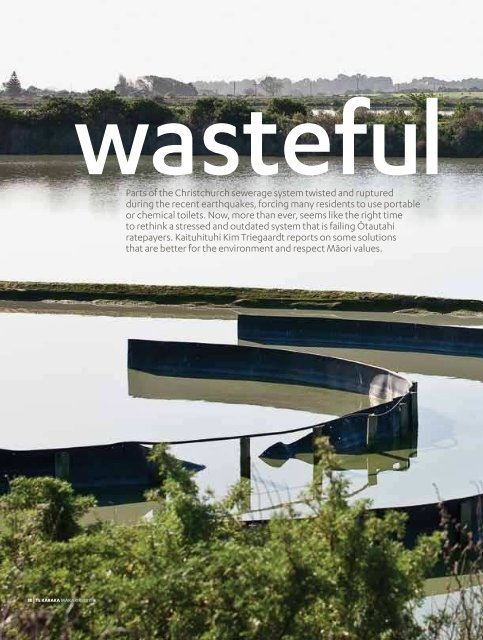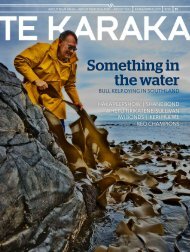Maraka! Maraka! Otautahi rises from the ruins - te karaka
Maraka! Maraka! Otautahi rises from the ruins - te karaka
Maraka! Maraka! Otautahi rises from the ruins - te karaka
You also want an ePaper? Increase the reach of your titles
YUMPU automatically turns print PDFs into web optimized ePapers that Google loves.
38 <strong>te</strong> KaraKa MaKarIrI 2011<br />
was<strong>te</strong>ful<br />
Parts of <strong>the</strong> Christchurch sewerage sys<strong>te</strong>m twis<strong>te</strong>d and ruptured<br />
during <strong>the</strong> recent earthquakes, forcing many residents to use portable<br />
or chemical toilets. Now, more than ever, seems like <strong>the</strong> right time<br />
to rethink a stressed and outda<strong>te</strong>d sys<strong>te</strong>m that is failing Ōtautahi<br />
ra<strong>te</strong>payers. Kaituhituhi Kim triegaardt reports on some solutions<br />
that are bet<strong>te</strong>r for <strong>the</strong> environment and respect Māori values.<br />
LITTLe eSCAPeD THe TRAIL OF DeSTRUCTION LeFT BY THe<br />
Sep<strong>te</strong>mber and February earthquakes and ongoing af<strong>te</strong>rshocks,<br />
including Christchurch’s vast sewage sys<strong>te</strong>m. The shat<strong>te</strong>red<br />
network left raw sewage flowing onto our beaches and into our<br />
rivers raising <strong>the</strong> question of whe<strong>the</strong>r it’s time for a rethink on<br />
how <strong>the</strong> city deals with its was<strong>te</strong>.<br />
Some of <strong>the</strong> answers may lie within a study that looked at al<strong>te</strong>rnative<br />
ways to manage was<strong>te</strong> that is less stressful on <strong>the</strong> environment<br />
and in line with Māori values.<br />
Tiaki Para is <strong>the</strong> result of a five-year research project looking at<br />
Māori and Ngāi Tahu perspectives on was<strong>te</strong> management and <strong>the</strong><br />
critical role for Māori in setting <strong>the</strong> future direction of how human<br />
was<strong>te</strong> is managed.<br />
Te Rūnanga o Ngāi Tahu environmental advisor and co-author<br />
of Tiaki Para, Craig Pauling (Ngāi Tahu – Ngāi Te Ruahikihiki),<br />
says that people generally don’t spend much time thinking about<br />
was<strong>te</strong> management practices, because, “poos just aren’t cool”.<br />
However, in Christchurch’s post earthquake environment<br />
people have been forced to think about it, as portable and chemical<br />
toilets replace flushing toilets and while <strong>the</strong> sewer pipes and<br />
Bromley Treatment plant are trying to be repaired.<br />
Christchurch has one of <strong>the</strong> flat<strong>te</strong>st sewerage sys<strong>te</strong>ms in <strong>the</strong><br />
world and <strong>the</strong> volume of was<strong>te</strong>wa<strong>te</strong>r is not sufficient to cause a<br />
rapid flow making it necessary to flush extra wa<strong>te</strong>r through <strong>the</strong><br />
pipes to move was<strong>te</strong> along. It is this use, of what is of<strong>te</strong>n referred<br />
to as “<strong>the</strong> best wa<strong>te</strong>r in <strong>the</strong> world”, which <strong>the</strong> Tiaki Para report is<br />
questioning and shedding new light on.<br />
Christchurch City Council wa<strong>te</strong>r and was<strong>te</strong> manager Mark<br />
Christison says <strong>the</strong> city had just star<strong>te</strong>d looking at its was<strong>te</strong>wa<strong>te</strong>r<br />
stra<strong>te</strong>gy when <strong>the</strong> Sep<strong>te</strong>mber earthquake hit.<br />
“This work is continuing but is slowed down by higher priority<br />
work at present. We are working with researchers at Can<strong>te</strong>rbury<br />
University and expertise <strong>from</strong> overseas looking at improving resilience<br />
of <strong>the</strong> was<strong>te</strong>wa<strong>te</strong>r network through <strong>the</strong> rebuild.”<br />
Christison believes that gravity sewers to a centralised treatment<br />
plant will continue to be <strong>the</strong> main stay of <strong>the</strong> was<strong>te</strong>wa<strong>te</strong>r<br />
sys<strong>te</strong>m, but that rebuilt sections will use modern ma<strong>te</strong>rials and<br />
construction <strong>te</strong>chniques, and are <strong>the</strong>refore likely to have added<br />
resilience in combating <strong>the</strong> effects of liquefaction and la<strong>te</strong>ral<br />
spreading.<br />
Dr Jamie Ataria (Ngāti Kahungunu, Rongomai Wahine,<br />
Ngāti Tūwharetoa) is co-author of <strong>the</strong> Tiaki Para report. He is<br />
an ecotoxicologist at Lincoln University who studies <strong>the</strong> effects<br />
of contaminants such as human was<strong>te</strong> on <strong>the</strong> environment.<br />
He believes February’s earthquake has given <strong>the</strong> city <strong>the</strong> opportunity<br />
to explore new and bet<strong>te</strong>r al<strong>te</strong>rnatives for a modern was<strong>te</strong><br />
treatment sys<strong>te</strong>m.<br />
“In Christchurch we use beautiful, clean aquifer wa<strong>te</strong>r to flush<br />
away our was<strong>te</strong>. It’s just used as a transport medium and <strong>the</strong> infrastructure<br />
to do that is what has broken and caused <strong>the</strong> problems<br />
af<strong>te</strong>r <strong>the</strong> quake.<br />
“Maybe it’s time to look at taking was<strong>te</strong> out of <strong>the</strong> wa<strong>te</strong>r, using<br />
composting toilets for instance, or even stop <strong>the</strong> use of wa<strong>te</strong>r at all.<br />
“We’ve got a blank sla<strong>te</strong>, so this could be <strong>the</strong> opportunity to<br />
crea<strong>te</strong> a demonstration suburb where you have different sys<strong>te</strong>ms<br />
for dealing with human was<strong>te</strong>.”<br />
Dr Kepa Morgan, senior lecturer in civil and environmental<br />
engineering at <strong>the</strong> University of Auckland, endorses <strong>the</strong> Tiaki Para<br />
report and says <strong>the</strong> current centralised was<strong>te</strong>wa<strong>te</strong>r sys<strong>te</strong>m goes<br />
against Māori protocol of respecting <strong>the</strong> mauri (spirit) of wa<strong>te</strong>r,<br />
especially when <strong>the</strong> was<strong>te</strong>wa<strong>te</strong>r is <strong>the</strong>n mixed into our rivers,<br />
lakes, harbours and seas, <strong>from</strong> where we collect our food.<br />
Morgan (Ngāti Pikiao, Te Arawa, Ngāti Kahungunu, Kāi Tahu<br />
– Kāti Kuri, Kāti Huirapa) agrees that now is <strong>the</strong> right time for<br />
Christchurch to be considering al<strong>te</strong>rnatives to a centralised<br />
sewerage sys<strong>te</strong>m. He says it’s all part of a “build back bet<strong>te</strong>r”<br />
philosophy where af<strong>te</strong>r a disas<strong>te</strong>r occurs a bet<strong>te</strong>r sys<strong>te</strong>m replaces a<br />
sys<strong>te</strong>m that is shown to be fallible.<br />
This approach can be difficult to implement because following<br />
a natural disas<strong>te</strong>r many people want things to return to normal as<br />
soon as possible and so can be resistant to new <strong>te</strong>chnologies that<br />
are unfamiliar, says Morgan.<br />
Morgan sugges<strong>te</strong>d af<strong>te</strong>r <strong>the</strong> Sep<strong>te</strong>mber quake that when <strong>the</strong><br />
council fixed <strong>the</strong> broken sewers <strong>the</strong>y considered installing a dry<br />
composting sys<strong>te</strong>m in one in <strong>te</strong>n houses.<br />
“The advantage with dry composting toilets is that <strong>the</strong>y do<br />
not require a wa<strong>te</strong>r source to opera<strong>te</strong> and will not fail if <strong>the</strong>re is<br />
no electricity supply. Therefore unless <strong>the</strong> dwelling is unsafe to<br />
occupy, <strong>the</strong> dry composting toilet should continue to be available<br />
for use immedia<strong>te</strong>ly af<strong>te</strong>r an earthquake.”<br />
Dry composting toilets are wa<strong>te</strong>rless toilets where was<strong>te</strong> is<br />
collec<strong>te</strong>d in a chamber below <strong>the</strong> toilet pedestal. A low-powered<br />
electric or solar fan sucks air <strong>from</strong> a vent pipe, creating a vacuum,<br />
eliminating odours inside <strong>the</strong> toilet cubicle and speeding <strong>the</strong><br />
composting process. A solar-powered hea<strong>te</strong>r can also be used to<br />
enhance <strong>the</strong> decomposition process. Although <strong>the</strong> toilets aren’t<br />
widely used in Ao<strong>te</strong>aroa, <strong>the</strong>re is a joint Australian-New Zealand<br />
standard for <strong>the</strong>ir installation and operation.<br />
Morgan says for a typical 5-person family a dry composting<br />
unit may only require emptying every two years. He adds that <strong>the</strong><br />
resulting compost is not toxic and can be added like fertiliser to<br />
<strong>the</strong> ground. Although, he says, as <strong>the</strong> Tiaki Para report suggests,<br />
it’s preferable not to put it straight onto <strong>the</strong> vegetable garden.<br />
The challenge ahead highligh<strong>te</strong>d in <strong>the</strong> Tiaki Para study is <strong>the</strong><br />
lack of understanding of Māori cultural beliefs and practices,<br />
in particular mahinga kai (food ga<strong>the</strong>ring) and <strong>the</strong> tapu ascribed<br />
to human bodily was<strong>te</strong>s, including things such as fingernails<br />
and hair.<br />
“The biggest thing we found was <strong>the</strong> depth and range of<br />
traditional beliefs that exist around dealing with was<strong>te</strong> and how,<br />
post-colonisation, <strong>the</strong>se traditional practices were supplan<strong>te</strong>d by<br />
modern <strong>te</strong>chnology and uninformed decision making that of<strong>te</strong>n<br />
inadver<strong>te</strong>ntly offended cultural values,” says Pauling.<br />
The study was designed to gain grea<strong>te</strong>r understanding of <strong>the</strong><br />
issues, and to document Māori and Ngāi Tahu perspectives on<br />
was<strong>te</strong> and preferences for was<strong>te</strong> management. It’s one of only a<br />
few reports that exist on <strong>the</strong> subject and highlights <strong>the</strong> critical role<br />
Māori should take to ensure was<strong>te</strong> management practices reflect<br />
<strong>the</strong>ir cultural values.<br />
For instance, <strong>the</strong> practice of discharging was<strong>te</strong> into a wa<strong>te</strong>rways<br />
or out to sea is problematic for Māori when it comes into<br />
contact with food ga<strong>the</strong>ring areas, because <strong>the</strong> pollu<strong>te</strong>d wa<strong>te</strong>r is<br />
seen to degrade <strong>the</strong> health of <strong>the</strong> area, even if <strong>the</strong> was<strong>te</strong> is trea<strong>te</strong>d.<br />
“Having a sewage outfall pipe over food beds hinders our<br />
ability to ga<strong>the</strong>r food safely, and in turn it impacts on our duties<br />
of manaakitanga and as kaitiaki,” says Pauling. “There are also<br />
<strong>te</strong> KaraKa MaKarIrI 2011 39



